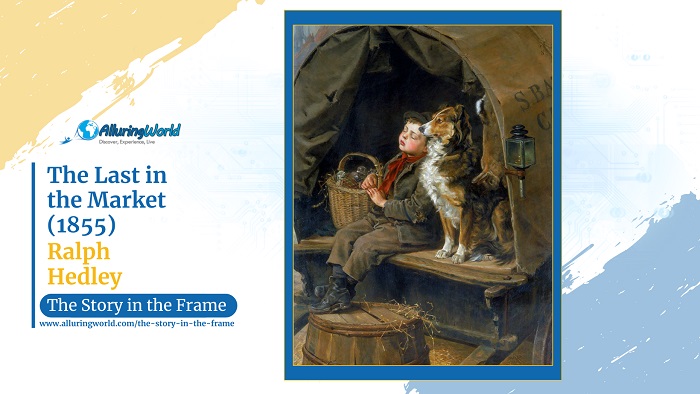The Last in the Market by Ralph Hedley is a poignant depiction of working-class life in 19th-century England that was painted in 1885 where the painting captures the atmosphere of a nearly empty marketplace, where a lone figure—likely a vendor or a customer—remains as the day’s trade comes to an end. Hedley, known for his realistic portrayals of everyday scenes, brings warmth and humanity to this composition, highlighting the resilience and struggles of working people in the industrial age.
About the Painter:
Ralph Hedley (1848–1913) was an English painter and woodcarver known for his detailed and empathetic portrayals of working-class life in the North of England. Born in Newcastle upon Tyne, Hedley became one of the leading figures in the regional art scene, producing genre paintings that documented the daily existence of laborers, craftsmen, and street vendors, and his work often carried a strong narrative element, emphasizing the dignity and perseverance of ordinary people. Through his art, he provided an invaluable visual record of Victorian life in industrial Britain.
Inspiration and Reasons Behind the Painting:
Hedley was deeply influenced by the social conditions of his time, particularly the struggles of the lower classes in industrialized cities, so the marketplace was a vital part of daily life, serving as a hub of economic activity and social interaction. The Last in the Market likely reflects the loneliness and hardship experienced by small traders and customers who remained until the very end of the day, hoping for a final transaction, and the theme of endurance and the quiet dignity of laborers was a recurring motif in Hedley’s work, reinforcing his commitment to social realism.
What is Depicted in the Painting:
The painting presents a dimly lit market scene, where a lone figure, accompanied by a dog, remains amidst the fading light. The individual, who is likely a figure of the working class, stands with a single basket, suggesting the end of their trading day, and the market’s environment is rendered with Hedley’s characteristic attention to detail, showcasing the rough textures of the cobbled street and the simple, functional architecture of the stalls. The composition emphasizes the quiet solitude of the scene, capturing the moment of transition between the market’s busy activity and its eventual stillness, and the presence of the figure and their canine companion evokes a sense of quiet resilience, reflecting the daily rhythms of life and the enduring spirit of those who worked within the market’s walls.
Colors and Techniques:
Hedley’s use of color in The Last in the Market is subdued and earthy, dominated by shades of brown, gray, and muted reds. This palette enhances the painting’s melancholic tone, reinforcing the atmosphere of a fading day and diminishing activity, where his brushwork is meticulous, with precise detailing in the textures of the wooden stalls, cobblestones, and worn clothing of the central figure. Hedley’s careful use of light and shadow adds depth and realism, drawing attention to the contrast between the warmth of the remaining lamp glow and the encroaching darkness of the evening.
Conclusion:
Overall, The Last in the Market is a powerful reflection of working-class life in Victorian England, capturing both the hardships and resilience of those who lived through it. Ralph Hedley’s ability to infuse his subjects with quiet dignity and realism makes this painting an enduring testament to the struggles and perseverance of everyday people, and today, it serves as an important historical document, offering insight into the social and economic realities of the 19th century while remaining a deeply moving work of art.

